Regaining Momentum
Finance & Development, September 2010, Vol. 47, No. 3
Delfin S. Go, Richard Harmsen, and Hans Timmer
Progress on the Millennium Development Goals has been slowed by the crisis. The rest of the world has to help
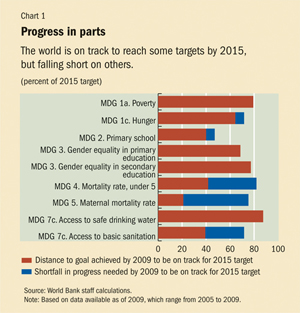
LOW-INCOME countries, particularly in sub-Saharan Africa, did relatively well during the recent global economic crisis, and developing countries are now recovering better than expected. But progress on the Millennium Development Goals (MDGs; see Box 1 and Chart 1) will be slow for many years. The impressive precrisis progress in economic growth and poverty reduction will not be matched for some time, and gaps or deviations in MDG progress from the precrisis trends will persist until 2020, five years after the 2015 target date for achieving the goals.
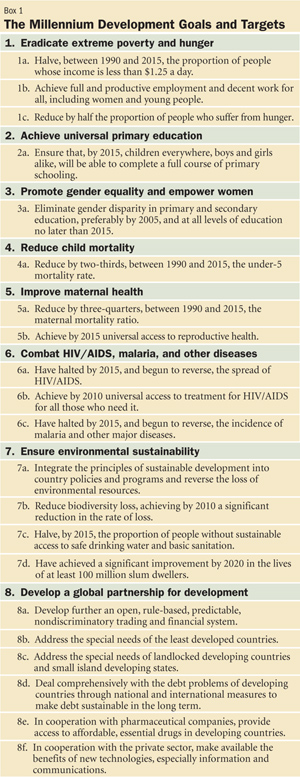
If we let the recovery slide and old patterns of policy failures, institutional breakdowns, and growth collapses persist, history tells us the adverse impact on human development, especially for women and children, will be devastating. So this is no time to be complacent. The international financial institutions and international community, having responded quickly and strongly to the crisis, need to do more to help developing countries regain their momentum toward achieving the MDGs.
Human development indicators improved significantly before the crisis hit in 2008, thanks to the acceleration of economic growth in many developing countries after the early 1990s. Overall progress on poverty reduction was particularly strong, even in Africa. Primary education, gender parity in primary and secondary education, and reliable access to improved water gained ground as well. But the picture isn’t so encouraging when it comes to the other MDGs—especially those related to health.
Regional variations
Globally, there is considerable variation across regions, countries, and income groups. Among regions, sub-Saharan Africa lags on all the MDGs, including poverty reduction. But that is only half the story—because the region did make progress. Sub-Saharan Africa was headed in the right direction for practically all the MDGs for more than 10 years, but the path to the goals was steeper in comparison with other regions because of Africa’s lower starting points. For example, the distance to the poverty target was difficult for Africa to traverse, because the 1990 incomes of much of Africa’s population were far below the poverty line. And Africa implemented reforms later than other regions and thus benefited later from accelerating income growth.
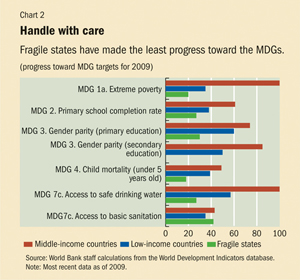
Progress has been slowest in fragile and conflict-affected states (see Chart 2). Wracked by conflict and hampered by weak capacity, these states—more than half of them in sub-Saharan Africa—present a difficult political and governance context for effective delivery of development financing and services. Fragile states account for close to one-fifth of the population of low-income countries but more than one-third of their poor people. Much of the challenge of achieving the MDGs will thus be concentrated in low-income countries, especially fragile states.
Middle-income countries have progressed fastest toward the MDGs. As a group, they are on track to achieve the target for poverty reduction. But many of them still have large concentrations of poverty, in part reflecting great income inequality. This concentrated poverty, together with large populations in some countries, means that middle-income countries remain home to a majority of the world’s poor in absolute numbers. Many middle-income countries also continue to face major challenges in achieving the non-income-related human development goals.
Successes
Extreme poverty is falling rapidly. Global poverty has fallen 40 percent since 1990, and the developing world is well on its way to reaching the global target of cutting income poverty in half by 2015 (relative to a 1990 baseline). Despite population growth, the number of poor people living on less than $1.25 a day in developing countries fell from about 1.8 billion in 1990 to 1.4 billion in 2005—from 42 percent of the population to 25 percent. Thanks to rapid growth, especially in China, east Asia has already cut extreme poverty in half. Poverty in sub-Saharan Africa has also been falling rapidly since the late 1990s, but the region is unlikely to reach the target, mainly because of its low starting point.
Universal primary education is within reach. There was an impressive increase in net enrollment rates in several low-income countries between 2000 and 2006. In more than 60 developing countries, over 90 percent of primary-school-age children are in school; the number of children not in school fell from 115 million in 2002 to 101 million in 2007, even with population growth. In 2007 the primary school completion rate reached 86 percent for all developing countries—93 percent for middle-income countries, but just 65 percent for low-income countries. For sub-Saharan Africa and south Asia, the lower ratios of 60 percent and 80 percent, respectively, in 2007 nonetheless represent advances over 1991’s 51 percent and 62 percent. But with 41 million primary-school-age children out of school in sub-Saharan Africa and 31.5 million in south Asia, meeting the target remains a difficult task.
Higher enrollment is shrinking the gender gap in education. Because more girls than ever are completing primary school, almost two-thirds of developing countries had gender parity at the primary school level by 2005, and the MDG 3 target of gender parity in primary and secondary education can be met by 2015. Sub-Saharan Africa is making good progress but is far behind the global target. Access to safe drinking water is on track globally and in most regions. Because of rapid expansion of infrastructure spending, more than 1.6 billion people gained access to improved sources of drinking water, raising the share of people with such access from 76 percent to 86 percent between 1990 and 2006. As many as 76 developing countries are on track to hit the target. But 23 developing countries have made no progress, and 5 others have fallen back.
Mixed or weak progress
Prospects are worst for the MDGs relating to health, such as infant mortality. The under-5 mortality rate in developing countries declined from 101 deaths for every 1,000 live births to 73 between 1990 and 2008, showing notable progress though not enough to meet the goal of reducing under-5 mortality by two-thirds (MDG 4). In 2008, 9 million children died from preventable diseases, compared with 13 million in 1990. Sub-Saharan Africa has 20 percent of the world’s children under age 5 but 50 percent of all child deaths. Progress in reducing infant mortality is also well short of the target in south Asia.
Maternal health is the least likely of the MDGs to meet the 2015 target. As many as 10,000 women in developing countries die every week from treatable complications of pregnancy and childbirth. But new findings from better data found a higher decline in the maternal death ratio than previously estimated (Hogan and others, 2010; see “Saving Mothers’ Lives” in this issue of F&D). Maternal deaths fell markedly from 422 for every 100,000 live births in 1980 to 320 in 1990 and to 251 in 2008. More than half of all maternal deaths were concentrated in six countries—Afghanistan, the Democratic Republic of the Congo, Ethiopia, India, Nigeria, and Pakistan. Bolivia, China, Ecuador, and Egypt have been making rapid gains, and 23 countries are on track to reach this MDG. In sub-Saharan Africa, the central and eastern regions have shown some improvement since 1990, but the southern and western regions faltered because of the number of pregnant women who died from HIV infection.
The recent food crisis has complicated progress on malnutrition and hunger. The developing world is not on track to halve the proportion of people who suffer from hunger. Child malnutrition accounts for more than a third of the disease burden of children under 5. And malnutrition during pregnancy accounts for more than 20 percent of maternal mortality. The proportion of children under 5 who are underweight declined from 33 percent in developing countries in 1990 to 26 percent in 2006, much slower than is needed to halve malnutrition by 2015. Progress has been slowest in sub-Saharan Africa and south Asia, where as many as 35 percent of children under 5—more than 140 million—suffer from severely to moderately stunted growth.
Halting the spread of major communicable diseases has proved difficult too. Although the rapid rise in the spread of HIV and in HIV-related deaths began to slow in recent years, an estimated 33.4 million people were living with HIV/AIDS in 2008. In that year, there were 2.7 million new infections and about 2 million AIDS-related deaths. Sub-Saharan Africa remains most affected, accounting for more than two-thirds of all people living with HIV and for nearly three-fourths of AIDS-related deaths in 2008. The prevalence of tuberculosis, which killed 1.8 million people in 2006, has been declining in all regions except sub-Saharan Africa. Mortality from malaria remains high, at about 1 million annually, and 80 percent of those who died were children in sub-Saharan Africa.
Vicious cycles
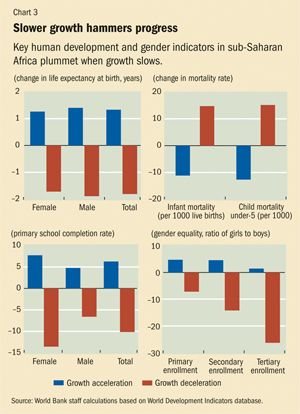
Historically, the impact of economic cycles on human development indicators has been highly asymmetrical. The deterioration in bad times is much greater than the improvement in good times (see Chart 3). For example, life expectancy is 2 years longer than the overall average during periods of accelerating growth, but 6.5 years shorter during deceleration. Infant mortality is 8 per 1,000 lower during acceleration and 24 per 1,000 higher during deceleration. The primary school completion rate is 4 percent higher during acceleration but 25 percent lower during deceleration. And the correlation between social indicators and periods of deceleration is stronger than the correlation between social indicators and periods of acceleration.
Vulnerable groups—infants and children, especially girls, and particularly in poor sub-Saharan countries—are affected disproportionately. For example, the life expectancy of girls and boys rises by 2 years during good times but falls by about 7 years for girls and 6 years for boys during bad times. The primary education completion rate rises 5 percentage points for girls and 3 percentage points for boys during good times (from their respective sample averages) but falls 29 percentage points for girls and 22 percentage points for boys during bad times. The female-to-male enrollment ratios for primary, secondary, and postsecondary education rise about 2 percentage points during growth acceleration but fall 7 percentage points (primary), 15 percentage points (secondary), and 40 percentage points (postsecondary) during deceleration. And once children are taken out of school, their future human capital is lowered permanently.
Distinguishing cause and consequence is difficult. Why are vicious circles during crises stronger than virtuous ones during prosperous times? Four reasons. The frequency of downturns, including conflicts, is high in low-income countries. The policy environment in many countries is poor, and economic indicators and political stability, voice and accountability, regulatory frameworks, rule of law, and government effectiveness tend to decline sharply during crises. Social spending shrinks in environments that lack a social safety net, and aid and its effectiveness tend to be under pressure. Declines in growth and service delivery to the poor—two basic drivers of development outcomes—appear to be critically disruptive, whereas the benefits during booms yield only gradual improvements.
This time, however, the global crisis was less devastating for poor countries, mainly because of better policies and institutions, stronger economic performance (see Box 2), higher aid, lower debt, and a beneficial external environment.
Box 2. Foundations for progress
Economic growth and stability are the foundation of the public spending that is needed to meet the Millennium Development Goals. So the prospects for further progress on the MDGs have to be assessed in light of macroeconomic developments in emerging and developing economies.
Despite a sharp drop in economic activity, many emerging and developing countries did better than feared at the beginning of the recent global economic crisis. In many countries, growth remained positive during 2009, and the recovery in 2010 is somewhat stronger than initially expected. Asian emerging and developing countries achieved more than 6.5 percent growth in 2009, and are projected to grow by more than 9 percent in 2010. On average, growth in the poorest countries remained positive as well last year: in sub-Saharan Africa growth remained above 2 percent, and the IMF projects that it will rise to 5 percent in 2010. On the other hand, emerging economies with large imbalances (eastern Europe) or close links to advanced economies (eastern Europe and Latin America) were more severely hit. And growth rates in many countries remain somewhat below precrisis levels, with risks on the downside because of sluggish and fragile economic activity in advanced economies.
Financial flows to emerging and developing countries are recovering as well. Sovereigns are borrowing at record levels, and emerging market bond spreads have come down to the levels of 2006 and 2007. Following a slowdown in 2009, private remittances are expected to pick up in 2010, and private sector access to financial markets has improved considerably. But overall, net financial flows to emerging and developing countries remain below precrisis levels, because bank financing and foreign direct investment have not fully recovered.
Several factors played a role in helping emerging and developing economies weather the crisis.
Countries that had strong policies before the crisis were able to post higher budget deficits than countries with more fragile debt and fiscal positions. Many countries supported domestic demand by keeping up their spending plans—including social spending— despite falling revenues. And some countries expanded their social safety net, mitigating the effect of the crisis on poverty.
Assistance from the IMF and the World Bank also helped many countries through the crisis. The IMF increased access to financing under existing financing facilities, bolstered reserves through an allocation of Special Drawing Rights equivalent to $250 billion, created a new facility for emerging economies with good track records (the Flexible Credit Line), reformed financing facilities for low-income countries, and streamlined conditionality. The World Bank and regional multilateral development banks increased commitments to $115 billion in 2009 to protect core development programs, strengthen the private sector, and help poor households. And the World Bank Group supported developing country exports by providing guarantees and liquidity for trade finance.
Finally, commodity prices rose in 2009—earlier than expected—softening the impact of the crisis on commodity-exporting economies.
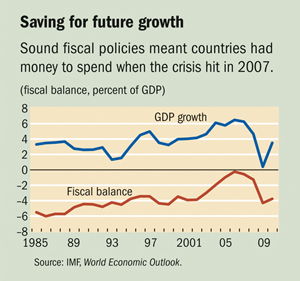
Rising economic growth in emerging and developing countries has been associated with improving fiscal policies over the past 15 years (see chart). In 2007, on the eve of the crisis, average budget deficits in these countries were only a fraction of those in the early 1990s, which allowed expansion of fiscal deficits in support of economic activity when the crisis hit. The developments witnessed in 2009 have underscored the importance of maintaining prudent macroeconomic policies in good times, to be able to face shocks and avoid social spending cuts during economic downturns.
Even so, the impact of the crisis on poverty will last a long time. Poverty rates will continue to fall after the crisis, but more slowly. By 2015 the global poverty rate is projected to be 15 percent, instead of the 14.1 percent it would have been without the crisis. The crisis will leave an additional 64 million people in extreme poverty by the end of 2010. The recovery will not make up all the lost ground. And for sub-Saharan Africa, the poverty rate is expected to be 38 percent by 2015, rather than the 36 percent it would have been without the crisis, lifting 20 million fewer people out of poverty.
The medium-term impact on other MDGs may also be considerable. Some 25 million fewer people may have access to improved water supplies. And the ultimate example of irreversible costs is that 265,000 more infants and 1.2 million more children under 5 might die between 2009 and 2015 as a result of the crisis.
Regaining momentum
Ultimately, achieving the MDGs depends on good policy actions in developing countries by governments, households, and firms. Broad-based economic growth needs to resurge, and macroeconomic policies have to be brought back onto a stable and sustainable path. Better domestic policies also mean improved service delivery and more domestic resources managed transparently and reasonably. Countries will have to improve the affordability, implementation, and coverage of targeted social safety nets, given their importance in supporting household incomes during times of distress. But the living conditions of poor people in low-income countries will improve only with additional resources and a favorable external environment. Donors need to deliver on their aid commitments and improve the predictability of aid flows. Healthy and expanding world trade and better market access for developing countries are also important. There is still much to do before 2015.
Delfin S. Go is a lead economist and Hans Timmer is Director, both at the World Bank’s Development Economics Prospects Group. Richard Harmsen is a Deputy Division Chief in the IMF’s Strategy, Policy, and Review Department.
References
Arbache, J., D. Go, and V. Korman, forthcoming, “Does Growth Volatility Matter for Development Outcomes? An Empirical Investigation Using Global Data,” background paper for Global Monitoring Report 2010 (Washington: World Bank).
Hogan, M., K. Foreman, M. Naghavi, S. Ahn, M. Wang, S. Makela, A. Lopez, R. Lozano, and C. Murray, 2010, “Maternal Mortality for 181 Countries, 1980–2008: A Systematic Analysis of Progress towards Millennium Development Goal 5,” The Lancet, Vol. 375, No. 9726, pp. 1609–23.
International Development Association, and International Monetary Fund, 2009, “Heavily Indebted Poor Countries (HIPC) Initiative and Multilateral Debt Relief Initiative (MDRI): Status of Implementation,” September 15 (Washington: World Bank and IMF).
International Monetary Fund (IMF), 2010, World Economic Outlook (Washington, April).
UNICEF, 2007, Progress for Children: A World Fit for Children Statistical Review, No. 6 (New York).
World Bank, and International Monetary Fund, 2010, Global Monitoring Report 2010: The MDGs after the Crisis (Washington: World Bank and IMF).


